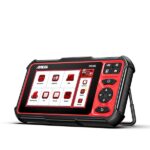Experiencing a low oil pressure warning in your vehicle can be alarming. Historically, these warnings have been the primary indicator of potential oil system issues. When that red oil can symbol illuminates on your dashboard accompanied by a “stop now” message, your immediate reaction should be to pull over and investigate. However, in modern vehicles equipped with sophisticated systems like OBD2, understanding live data can provide crucial insights and potentially prevent unnecessary panic. This article will explore how to use OBD2 live data to effectively monitor your car’s oil pressure and what to do when you encounter a warning.
Deciphering Oil Pressure Warnings: Sensor or System Failure?
For many years, a low oil pressure light was a straightforward signal: your engine was likely experiencing critically low oil pressure, demanding immediate attention to avoid severe engine damage. While this remains a serious concern, advancements in automotive technology have introduced a common scenario: false oil pressure warnings. These spurious alerts often stem from a failing oil pressure sensor rather than an actual drop in oil pressure.
Imagine this situation: you’re driving, and suddenly the oil pressure warning flashes, urging you to stop immediately. Naturally, your heart races. But what if your vehicle, like some models, has a separate oil pressure gauge? If you’re quick-thinking enough to glance at it, you might notice it reading normal, contradicting the warning light. This exact situation occurred with a GMC 2500HD, highlighting the discrepancy that can arise between the warning system and the actual oil pressure.
Alt text: Analog oil pressure gauge showing normal reading in a car dashboard, contrasting with a potential false warning light.
It’s crucial to emphasize: never ignore a low oil pressure warning if you lack an oil pressure gauge or the means to verify the actual pressure. However, if your vehicle provides an oil pressure gauge, observing it just before turning off the engine can offer valuable clues and potentially save you from unnecessary stress and worry.
The Role of OBD2 Live Data in Oil Pressure Diagnostics
This is where OBD2 (On-Board Diagnostics II) and live data become invaluable. OBD2 systems are standard in most modern vehicles and provide access to a wealth of real-time engine data, including – crucially – oil pressure readings. By connecting an OBD2 scanner to your car’s diagnostic port, you can access live data streams that display the actual oil pressure as measured by the engine’s sensors.
This live data offers a significant advantage over simply relying on a warning light or even a basic gauge. It allows for a more nuanced understanding of your oil pressure system’s behavior. You can monitor the pressure under various driving conditions – idle, acceleration, highway speeds – and identify any inconsistencies or fluctuations that might indicate a problem.
Furthermore, OBD2 systems often record diagnostic trouble codes (DTCs) when issues arise. In the case of a faulty oil pressure sensor, a common code you might encounter is P0520, indicating a problem with the oil pressure sensor circuit. However, as experienced, this code might not appear immediately, even when false warnings are occurring. Therefore, relying solely on DTCs might not be sufficient for immediate diagnosis, making live data monitoring even more critical.
Alt text: OBD2 scanner tool plugged into the diagnostic port of a vehicle, used for accessing live data including oil pressure.
Interpreting OBD2 Oil Pressure Live Data
When accessing oil pressure data via an OBD2 scanner, you’ll typically see readings in PSI (pounds per square inch) or kPa (kilopascals). Normal oil pressure ranges vary depending on the vehicle, engine type, and operating conditions. Generally, you can expect to see higher pressure when the engine is cold and at higher RPMs, and lower pressure when the engine is warm and idling.
Consult your vehicle’s repair manual or a reliable online resource to determine the specific normal oil pressure range for your car model. With live data, you can observe:
- Consistent Readings: Stable readings within the normal range across different engine speeds and temperatures generally indicate a healthy oil pressure system.
- Intermittent Drops: Occasional dips in pressure, especially under specific conditions (like hard acceleration or idling), could signal a developing issue.
- Consistently Low Readings: Continuously low oil pressure readings, especially when accompanied by a warning light, require immediate investigation as they may indicate a genuine oil pressure problem.
- No Readings or Erratic Readings: This could point to a faulty oil pressure sensor or issues with the sensor circuit, potentially triggering false warnings.
Oil Pressure Gauges vs. OBD2 Monitoring
While adding an aftermarket oil pressure gauge might seem like a solution, it’s worth considering the capabilities of your vehicle’s existing OBD2 system. For most everyday road vehicles, investing in a separate oil pressure gauge might be less practical than utilizing an OBD2 scanner for comprehensive diagnostics.
OBD2 offers a broader range of live data parameters beyond just oil pressure, including engine temperature, RPM, and various sensor readings, providing a more holistic view of your engine’s health. In fact, a reliable temperature gauge, displaying actual coolant temperature rather than a buffered “normal” range, is often considered more critical than a dedicated oil pressure gauge for typical street driving.
Conclusion: Informed Action with OBD2 and Oil Pressure
Encountering a low oil pressure warning is undoubtedly concerning. However, with the advent of OBD2 technology, you are no longer limited to reacting solely to a warning light. By utilizing an OBD2 scanner to access live oil pressure data, you can gain a more informed understanding of your vehicle’s condition, differentiate between sensor malfunctions and genuine pressure issues, and take appropriate action. Remember, while OBD2 provides valuable diagnostic information, always prioritize caution and seek professional mechanic advice if you suspect a real oil pressure problem.

